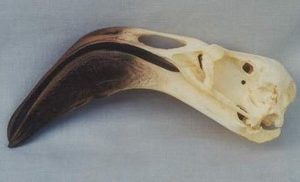Roseus Skull Replica or Greater Flamingo measures 6.3 inches & is museum quality polyurethane cast. 2-part skull (separate cranium and jaw). Made in USA.
The Roseus or Greater flamingo (Phoenicopterus roseus) is the most widespread and largest species of the flamingo family. Common in the Old World.
They are found in Northern (coastal) and Sub-Saharan Africa, the Indian Subcontinent (south of the Himalayas), the Middle East, the Levant, the Persian Gulf, the Gulf of Aden, the Red Sea, and the Mediterranean countries of Southern Europe.
The Roseus or Greater flamingo is the largest living species of flamingo, averaging 43 to 59 in. tall and weighing 4.4 to 8.8 lb. The largest male flamingos have been recorded to be up to 74 in. tall and to weigh 9.9 lbs.
Most of the plumage is pinkish-white, but the wing coverts are red and the primary and secondary flight feathers are black. The bill is pink with a restricted black tip, and the legs are entirely pink. The call is a goose-like honking.
Roseus or Greater flamingo chicks are covered in gray fluffy down. Subadult flamingos are paler with dark legs. Adults feeding chicks also become paler, but retain the bright pink legs.
The coloration comes from the carotenoid pigments in the organisms that live in their feeding grounds. Secretions of the uropygial gland also contain carotenoids.
During the breeding season, greater flamingos increase the frequency of their spreading uropygial secretions over their feathers and thereby enhance their color. This cosmetic use of uropygial secretions has been described as applying “make-up”.
The first recorded zoo hatch was in 1959 at Zoo Basel. In Zoo Basel’s breeding program, over 400 birds have been hatched with between 20 and 27 per year since 2000.
The oldest known greater flamingo was a bird at the Adelaide Zoo in Australia that died at the age of at least 83 years. The bird’s exact age is not known; it was already a mature adult when it arrived in Adelaide in 1933. It was euthanized in January 2014 due to complications of old age.

